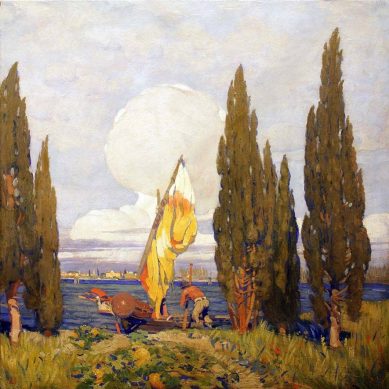You searched
Painter
Salvatore Valeri
Are you interested in the sales or the purchase of his artworks?
We buy works of this artist
and of other painters and sculptors from the 16th century to the first half of the 20th century
The Berardi gallery offers a free and without obligation service for evaluation of ancient and modern art . To find your way in the art market, very complex and full of nuances, it is better to rely on a professional consultant who can answer fast and concretely to your needs. The clarity of the answers will resolve effectively the need to estimate or sell an asset.
Contact us immediately without commitment
Answers also in 24 hours:
Salvatore Valeri
Salvatore Valeri
Salvatore Valeri was born in Nettuno in 1856. He trained in Rome at the Accademia di San Luca, where he was a pupil of Cesare Maccari. After his years of study, he decided, while still very young, to make an adventurous journey to the Middle East.
His first stop was Turkey, where he stayed for several years. Initially, he lived from hand to mouth, supporting himself by selling Orientalist impressions, with which he mainly won over European travellers. Then he gradually began to work as a private painting teacher, often changing cities, and soon showed his tireless nature as a traveller and painter.
Career in Constantinople: Valeri court painter and teacher
In 1880, he found a certain stability by settling in Constantinople, a magical place that enveloped and welcomed him and which he chose as his adopted city. Perhaps because it was here that he also found his fortune as an orientalist painter: noticed by the English ambassador Lord Dufferin, thanks to the extreme fluency and luminosity of his views, he was invited to hold an official exhibition, also presided over by Sultan Abdul Hamid II, who was immediately fascinated by Salvatore Valeri’s works.
Having recently opened the School of Fine Arts in Constantinople, he was appointed teacher of painting and became its director from 1883 to 1915. In the meantime, he was also tutor to the sultan’s three sons, as Şehazadelerin öğretmeni, “teacher of the princes”. He was, in fact, a court painter and received the rank of Bey from the Sultan, the appointment as an official of the sultanate. At court, he worked mainly on family portraits, without ever abandoning his vocation as a landscape painter. One of his most important portraits is that of Wilhelm II of Germany, on a trip to Constantinople, hosted by the Sultan around 1914.
Among the genre scenes and Orientalist views, which are rich in light and constructed through a brushstroke of small vibrant touches of bright colour, are Gypsy Dancing, Waterman, Old Camel Driver, Gypsy, Man Playing the Guitar, Arrival of a Caravan in a Village, Leaving for War, Transporting a Wounded Man, Caravan in the Desert.
He remained in Constantinople until 1915: with the outbreak of the First World War, his experience as a teacher and court painter in Turkey came to an end. In 1916, at the same time as the start of the tragic Armenian genocide, he returned to Italy to protect his wife Maria Lekegian, who was of Armenian origin.
When he returned to his home town of Nettuno, he decided to open a painting school, which he directed for several years. He continued to paint with his usual luminosity, but the Orientalist landscapes were gradually replaced by views and seascapes inspired by Neptune and its surroundings.
Elena Lago





